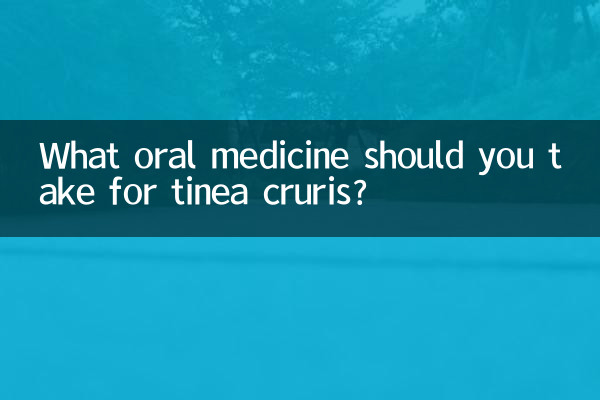What oral medicines should be taken for tinea cruris: a comprehensive analysis of treatment options and hot topics
Recently, the treatment of tinea cruris has become one of the hot topics on the Internet, especially the choice of oral drugs, which has triggered widespread discussion. This article will combine the hot content on the Internet in the past 10 days, conduct a structured analysis of the oral drug treatment options for tinea cruris, and provide practical suggestions.
1. Overview and treatment principles of tinea cruris

Tinea cruris is a common fungal infectious skin disease, mostly caused by Trichophyton rubrum, Trichophyton mentagrophytes, etc. Treatment is mainly antifungal drugs, which are divided into two types: topical drugs and oral drugs. Oral medications are a more effective option for patients with larger areas, recurrent attacks, or in whom topical medications are not effective.
| Treatment | Applicable situations | Course of treatment |
|---|---|---|
| Topical antifungals | Mild, localized infection | 2-4 weeks |
| Oral antifungals | Moderate to severe, widespread infection | 1-2 weeks |
2. Comparison of commonly used oral antifungal drugs
According to recent discussions on medical forums and health platforms, the following are the oral antifungal drugs that patients are most concerned about:
| Drug name | common name | Usage and dosage | Things to note |
|---|---|---|---|
| Terbinafine | Terbinafine hydrochloride tablets | 250mg/day for 1-2 weeks | Use with caution in patients with abnormal liver function |
| itraconazole | itraconazole capsules | 200mg/day for 1 week | Do not take it with antacids |
| fluconazole | fluconazole tablets | 150mg/week, for 2-4 weeks | Renal insufficiency requires dose adjustment |
3. Answers to recent hotly discussed questions on the Internet
1.Which is better, oral medication or topical medication?Experts suggest: Mild patients can use topical drugs alone; moderate to severe patients are recommended to take combined treatment, with oral control first and then external use for consolidation.
2.Will taking antifungal drugs damage your liver?There is a certain risk of hepatotoxicity, but the incidence is low. Liver function needs to be checked before medication and avoid drinking alcohol during medication.
3.Can children take oral antifungals?Medical advice must be strictly followed. Terbinafine can be used in children over 2 years old, and itraconazole can be used in children over 5 years old.
4. Adjuvant treatment and life adjustment suggestions
| Suggested categories | Specific measures |
|---|---|
| Laundry treatment | Change underwear every day, wash in boiling water or expose to sunlight |
| environmental control | Keep the affected area dry and avoid sitting in a humid environment for long periods of time |
| diet conditioning | Eat less spicy food and supplement vitamin B in an appropriate amount |
5. Latest Treatment Progress and Internet Hotspots
1. A recent clinical study conducted by the dermatology department of a tertiary hospital shows that the cure rate of terbinafine combined with topical naftifine and ketoconazole cream can reach 92.3%.
2. The topic of "Can Chinese medicine cure tinea cruris" is a hot topic on health platforms: Experts point out that some Chinese medicines do have auxiliary effects, but they cannot replace antifungal drugs.
3. Discussion on "recurrence of tinea cruris" on social media: Emphasis on the importance of standardized medication and thorough disinfection to avoid voluntary discontinuation of medication, which may lead to drug resistance.
Summarize:Oral drug treatment for tinea cruris needs to be selected according to individual conditions. Terbinafine, itraconazole and fluconazole are the three most commonly used drugs. During the treatment period, you should follow the doctor's advice, pay attention to liver function monitoring, and coordinate with lifestyle adjustments to achieve the best results. If symptoms persist or worsen, follow-up visits should be made in a timely manner to adjust the treatment plan.

check the details

check the details